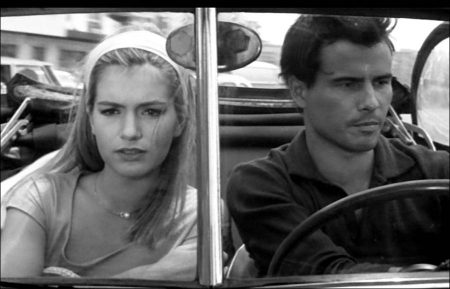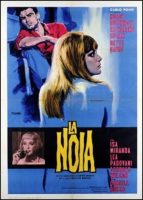Taglines: Not with love – Not with money – They cannot satisfy themselves or each other!
The Empty Canvas movie storyline. The son of a wealthy American woman and a deceased Italian nobleman, Dino, dabbles away at painting. Thinking he has found the image for his “empty canvas”, he takes up with man-crazy nymphet Cecilia, who refuses to marry him–even after he covers her nude body with 10,000-lire banknotes. She does agree to become his mistress–until a more interesting man comes along. Dino has a breakdown and is guided back to health by his mother. He tells her at fadeout that now he has suffered, and he thinks he might be able to fill that empty canvas.
The Empty Canvas is a 1963 Italian drama film directed by Damiano Damiani. The screenplay by Damiani, Tonino Guerra, and Ugo Liberatore is based on the best-selling novel La Noia by Alberto Moravia. The film stars Horst Buchholz, Catherine Spaak, Bette Davis, Isa Miranda, Lea Padovani, Daniela Rocca, Georges Wilson, Micaela Dazzi, Mario Lanfranchi, Edoardo Nevola and Renato Moretti.
Film Review for The Empty Canvas
The acrid, sexual flavoring of Alberto Moravia’s pen coils through “The Empty Canvas” like a dank, synthetic mist.That’s about all there is to the screen version of his best-selling novel, produced in Italy, in English, by Carlo Ponti and presented by Joseph E. Levine yesterday at the Embassy and Murray Hill Theaters. Co-starred are Horst Buchholz, Catherine Spaak and, probably to her eternal regret, “Miss Bette Davis.
“For all its droopy-eyed suavity, flehly fixation and blandly decadent facade of modern Roman society, this is essentially an old-fashioned yarn about a “lost” young man caught between, a bad girl and a possessive mama, no angel herself. Not until the final reel, with the cynical youth desperately trying to anchor the quicksilver wanton, does the picture really come to life. And by then it doesn’t matter.

That’s the real moral, or so it would seem.For the most part, under Damiano Damiani’s studied direction, the incidents move in stilted, crabwise fashion, exposing three rather dull and bloodless specimens. What a trio!As the focal point, Mr. Buchholz is a squinty, humorless artist who decides he can’t paint—too lazy, apparently—until Miss Spaak, as a model, wiggles in from the adjoining studio and starts posing, to put it mildly. She never stops, in fact, and how Miss Spaak escaped catching pneumonia is about as profound a question as the picture ever raises.Meanwhile, back at a luxurious Roman villa, broods Miss Davis.
As an American-born widow, not above using comely servants to lure her elusive son, Miss Davis’s “Countess” is truly a sight, looking like a Pekingese under a blonde bob and growling an atrocious Southern accent.”It’s yores with man blessin,'” she tells her peevish son, indicating a birthday car.At times, especially under-scored by Miss Davis’s withering expression and lava lingo, the picture’s overripe sexuality is downright funny.
At one point, for instance, she presides at dinner like a cobra as she watches Mr. Buchholz paw a servant. Even funnier is her saucer-eyed discovery of the two young people in her bedroom.But the picture only pulls up taut toward the middle, when the spoiled hero first sees the threadbare home background of his steamy young mistress.
This a good, thoughtful sequence. And what follows—Mr. Buchholz’s hysterical attempt to hold Miss Spaak—clips off steadily and convincingly.Isa Miranda, as an uneasy mother, and Lea Padovani, as an artist’s widow, make side-line roles count ever so briefly.On the whole, though, its wise theatricality keeps it an “Empty Canvas.” “That’s all there is,” says Mr. Buchholz in one scene, showing a blank space. He’s right.
The Empty Canvas (1963)
Directed by: Damiano Damiani
Starring: Horst Buchholz, Catherine Spaak, Bette Davis, Isa Miranda, Lea Padovani, Daniela Rocca, Georges Wilson, Micaela Dazzi, Mario Lanfranchi, Edoardo Nevola, Renato Moretti
Screenplay by: Damiano Damiani, Tonino Guerra, Ugo Liberatore
Production Design by: Antonio Altoviti, Carlo Lastricati
Cinematography by: Roberto Gerardi
Film Editing by: Renzo Lucidi
Set Decoration by: Dario Micheli
Art Direction by: Carlo Egidi
Music by: Luis Bacalov
MPAA Rating: None.
Distributed by: Embassy Pictures
Release Date: December 4, 1963
Views: 336


